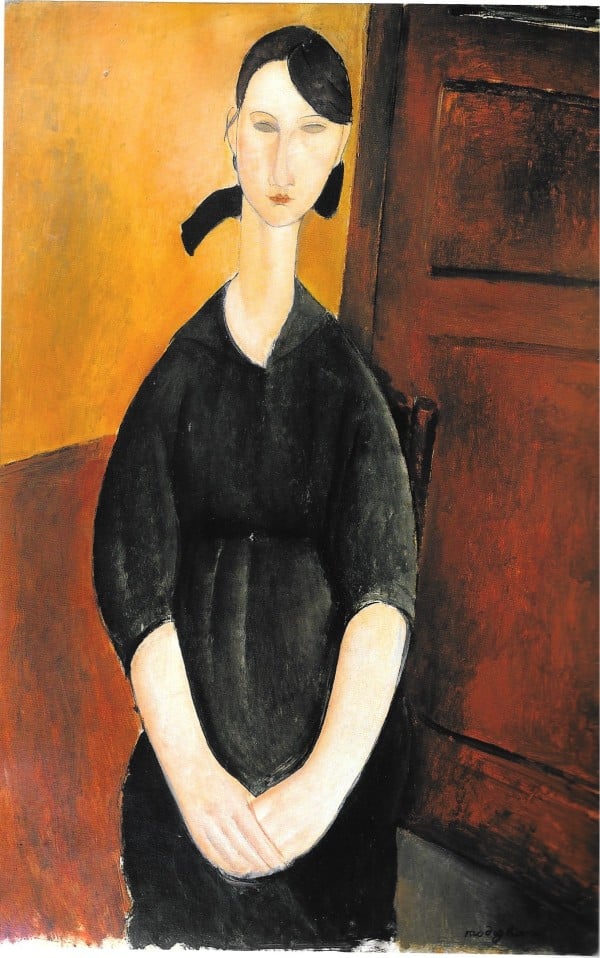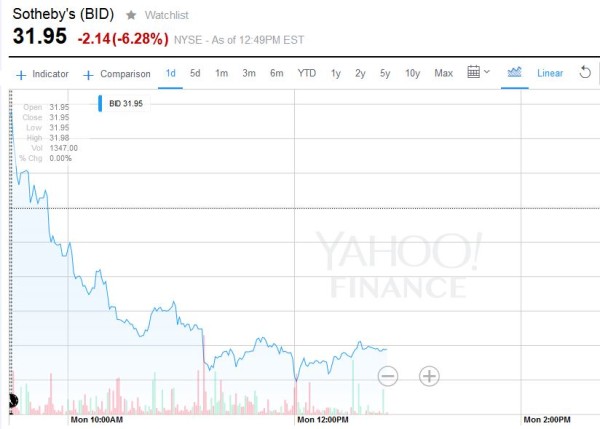Analysis
Sotheby’s Explains Why It Had to Give $500 Million to Taubman Heirs—And Lose Money
Executives told shareholders they had to do it.

Executives told shareholders they had to do it.

Eileen Kinsella

Monday morning, Sotheby’s released third-quarter earnings. While the auction house reported a narrower-than-expected loss-per-share of 26 cents compared with expectations of 27 cents, in a conference call with investors and analysts Monday morning, it seemed all anyone wanted to focus on—including current president and CEO Tad Smith himself—is the current fourth quarter sales and Sotheby’s whopping $500 million guarantee to secure the collection of former chairman A. Alfred Taubman.

Amedeo Modigliani’s Paulette Jourdain (1919) was the highest selling lot of the Taubman Masterworks sale at Sotheby’s last week, fetching $42.8 million.
Image: Courtesy of Sotheby’s.
Perhaps most interesting was the emphasis on covering the massive outlay as opposed to any foreseeable profit or upside on it.
While noting that auctions “achieved $780 million, led by the first two sales” from the Taubman collection last week, Smith and other Sotheby’s representatives took pains to emphasize that the primary goal here is making back the money Sotheby’s shelled out to secure the collection (a guarantee that might have hurt private sales).
Smith used the conference call to explain his position on the guarantee.
“‘We will not roll dice in the auction room with shareholders’ money,” Smith recalled telling shareholders and investors in his first call with them. “At the same time, guarantees on high-profile trophy lots can be important marketing investments and potentially generate positive momentum and product scope within our categories. Strategy, opportunity, judgement, and sensible risk management will guide our use of these guarantees.”
“Some have asked me whether the Taubman guarantee which, thus far, has not involved any third-party hedges is a sign of things to come under my leadership,” Smith continued. “The answer is no. There was only one Alfred Taubman. Only his collection has both the size and the uniqueness to Sotheby’s shareholders to make this consignment important to win.”
A number of sources told artnet News the bottom line is Sotheby’s could not have risked losing the collection to arch-rival Christie’s since—from a business standpoint—it would have been unacceptable, not to mention impossible to explain, why heirs of the former chairman of Sotheby’s opted to sell his collection through its biggest competitor. From a marketing standpoint, it would have been an unprecedented instance of worlds colliding.
And that’s even before one considers that Taubman was the only executive to serve time in prison for his role in a price fixing scandal that was prosecuted by federal investigators in the late 1990s. Christie’s cooperated with authorities and Taubman’s UK counterpart, Sir Anthony Tennant, refused to come to the US to stand trial. Under UK laws, he could not be extradited.
Later in the call, CFO Patrick McClymont further parsed the guarantee.
“We want to highlight to investors that, with the Taubman guarantee, Sothebys is not entitled to receive a commission until aggregate proceeds—which is hammer plus buyer premium—exceed the amount of the guarantee,” said McClymont. “However, the corresponding sales and results, and promotional expenses will be recorded in both the fourth quarter of 2015 and first quarter 2016 results. As we think about the Taubman guarantee, we want to point out that the tally of aggregate proceeds includes the estimated value of items that failed to sell at auction which are taken into our inventory. Accordingly this will reduce our overall commission margin for the fourth quarter rand full year 2015.”
Sotheby’s will sell more property from Taubman’s collection across upcoming sales of American art in November and Old Masters in January.
However, during the Q&A session with financial analysts that followed Sotheby’s earnings presentation, one analyst cut to the chase, asking abouton the Taubman guarantee, “Can you let us know if you expect to make or lose money?”
“So the way to think about it,” McClymont responded, “whatever happens in the room in terms of hammer and then buyers premium, all counts towards covering the guarantee. So far we have aggregate proceeds of about $420 million and then to-be-sold property. . .that probably gets you close to another $60 million and then the balance to get to the total guarantee amount is any property that [failed to sell] and then we have to mark that to market and include it in our balance sheet…We believe that those will allow us to cover the guarantee.”
McClymont added that some items that failed to sell during the auctions last week have already been snapped up post-auction at “prices that we found attractive.”

Shares of Sotheby’s stock were trending lower following this morning’s earning report.
Source: Yahoo Finance.
Shares of Sotheby’s stock were trading just under $32 a share, down more than $2, or down six percent in trading from its opening stock price on the New York Stock Exchange, following this morning’s report.